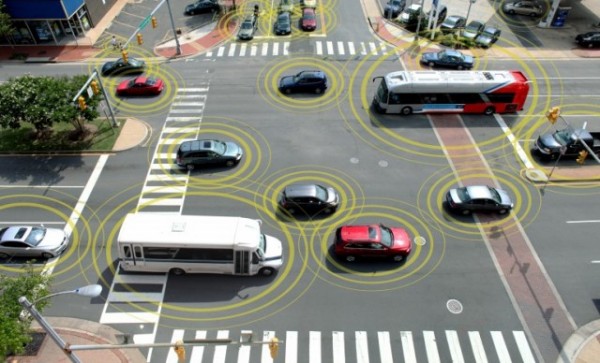Ford Demonstrates V2V Communication If Cars “Talked” To Each Other
A new demo by Ford shows us what it would really be like if cars communicated with each other. By using technology, known as V2V (vehicle-to-vehicle), it would be possible for vehicles to warn each other of their position on the road, and ultimately prevent traffic accidents. Systems such as these could be mandated for use in your vehicle in the near future, so start getting used to the idea of seeing the technology in person soon. This could also represent the first major step towards the reality of self-driving cars.
V2V Demonstration
Ford’s new demonstration took place at a fake intersection with their drivers controlling each vehicle. When the vehicle reached traveling speed, a re-creation of a real-life stall at an intersection alerted the driver with lights and sounds.

Source: U.S. Dept. of Transportation
The Ford Taurus in the demo received data from the other V2V enabled vehicle, processed the information in the car’s computer, calculated the likelihood of a crash, and then alerted the driver to apply the brakes.
This V2V technology incorporates a GPS and a Dedicated Short Range Communication (DSRC) transceiver which operates over the 802.11p range. The vehicles each send out their GPS location, current path, and speed while also receiving signals sent out from other vehicles in the area.
[niceyoutubelite id=”PF1a-g9suR8″ width=”600″]
Using this system, vehicles would be able to alert the other cars that they need to “watch out” for trouble ahead so they can alert their drivers of things to avoid — the vehicle “dialog” is sent wirelessly in binary code. For example, if a car was broken down in the lane ahead, an alarm would go off to alert you to stop. The range of the system is about 1,500 feet, which is enough distance for a driver to come to a safe stop if they are traveling within most speed limits.
Coming Soon to a Vehicle Near You
This technology will only work to prevent crashes if the majority of vehicles on the road are utilizing it. The National Highway Traffic and Safety Administration (NHTSA) is publishing their recommendations within a few weeks for the V2V equipment to be installed in all cars. It is likely that federal mandates will call for systems like these to be used by all vehicles on the road. Automakers are very anxious to get rules established for this technology.
With this kind of system, there are no external sensors or radars needed, which is what many current avoidance systems use. Installing the technology into the demo car took mild modification. Since the technology is rather simple, aftermarket systems could be fairly inexpensive to install on vehicles made without it.
The vehicle-to-vehicle communication systems are not self-driving cars by any means, but they are somewhat of a first “real” step towards them. Self-driving vehicles would rely heavily on technologies like these, but the vehicle would be in control to make the evasive maneuvers instead of the driver. However, autonomous vehicles are still many years in the future.
Would you voluntarily install such a system in your vehicle if could potentially save a life or save money and expense of a collision repair?





